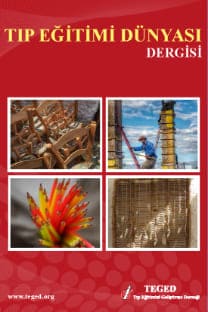Ahmet ERGİN, Emel DİKBAŞ, Ali İhsan BOZKURT, Gamze ATÇEKEN, Havva GÜRBÜZ, Cansu YILMAZ, Saadet Nilay ÇÖLBE, Ufuk TAŞCI, Leyla GÜLDAMLA, Halil İbrahim DEMİRCAN
TIP FAKÜLTESİ ÖĞRENCİLERİN MEZUNİYET SONRASI KARİYER SEÇİMİ VE ETKİLEYEN FAKTÖRLER
Amaç: Bu çalışma Pamukkale Üniversitesi Tıp Fakültesi öğrencilerinin mezuniyet sonrası kariyer seçimi ve bu seçimi etkileyen faktörleri araştırmak amacı ile yapılmıştır. Gereç ve Yöntem: Kesitsel tipteki bu araştırma gerekli izinler alındıktan sonra Şubat 2011 tarihinde Pamukkale Üniversitesinde tamamlandı. Araştırmaya Tıp Fakültesi 1., 3.,ve 6. sınıfta okumakta olan toplam 203 öğrenci katıldı. Çalışmaya katılan öğrencilerin %49,8’i birinci, %34’ü üçüncü ve %16,3’ü altıncı sınıftadır. Anket formunda katılımcıların sosyodemografik özellikleri ve mezun olduktan sonraki kariyer planına yönelik sorular yer almaktadır. Katılımcıların sosyoekonomik düzeyleri Aile Refahı Ölçeği ile ölçülmüştür. Bulgular: Öğrencilerin %70.2’si mezun olduktan sonra TUS’u kazanıncaya kadar bir süre pratisyen hekim olarak çalışmayı planlamaktadır. Bu seçimde en önemli faktörlerin ‘ekonomik olarak bağımsız olmak’ (%53.1) ve ‘tecrübe kazanmak’ (%49.3) olduğu görülmektedir. Tüm sınıflarda uzman hekim olma isteme nedenleri arasında ‘mesleki tatmin’ ilk sıradadır (%71.9). Öğrencilerin uzmanlık dalı tercihlerine bakıldığında cerrahi bilimlerin tercih edilme oranı sınıf arttıkça azalmaktadır (1., 3. ve 6. sınıflarda sırasıyla %53.4, %41.0 ve %26.7, p=0,03). Tüm dönemler toplamında, öğrencilerin uzmanlık seçimlerinde birinci sırada kardiyoloji yer alırken ikinci sırada göz hastalıkları yer almaktadır. Çoklu değişkenli analiz kız öğrencilerin ve 6. sınıfların dahili bilimlerde daha fazla uzmanlaşmak istediklerini ortaya koymuştur. Sonuç: Sağlık hizmetlerinin sunulmasında özellikle birinci basamak hekimlerinin rolünün büyüklüğüne rağmen öğrencilerimizin büyük çoğunluğu diğer basamaklarda uzmanlaşmayı yeğlemektedirler. Aşırı uzmanlaşmaya yol açma riski sebebiyle mevcut durumu değiştirecek önlemlerin hayata geçirilmesi kanımızca uygundur.
Anahtar Kelimeler:
Tıp fakültesi, Ögrenci, Kariyer Planı, Egitim, Uzmanlık
Career Choices of Medical Faculty Students After Graduation and Affecting Factors
Aim: The aim of this study was to examine career choices, and affecting factors, of medical students after graduation at Pamukkale University, Denizli. Materials and Methods: This cross-sectional study was carried out in February, 2011. A total of 203 students at the 1st, 3rd and 6th class were included in the study. Forty nine point eight percent of the students were in their 1st year, 34% in their 3rd and 16.3% in their 6th year in the Faculty. In the survey there are questions on the sociodemographic characteristics of the participants and their career plans after graduation. The socioeconomic levels of the participants were measured with the Family Affluence Scale. Results: After graduation, 70.2% of the students were planning to work as a medical practitioner while studying for the Specialty Entrance Exam (TUS). The most important factors in this choice were “becoming economically independent” (53.1) and “gaining experience” (%49.3). The overall mostly stated reason for choosing specialization was “professional satisfaction” (71.9). The rate of choosing surgical specialty decreased by the class of the student (53.4%, 41.0% and 26.0%, in the 1st, 3rd and 6th class, respectively, p=0.03). Overall, cardiology was the first choice specialty of the students and ophthalmology was the second. Multivariate analysis showed that female students and the 6th class students wanted to mostly specialize in medicine. Conclusions: Despite the important role of primary care physicians in the provision of health services, the vast majority of our students prefer specialization. Due to the risk of over specialization the suitable measures need to be implemented to change the current situation.
Keywords:
Medical faculty, students, career plan, education, specialization,
___
- Boelen C. The five-star doctor. An asset to health care reform? www.who.int/entity/hrh/en/HRDJ_1_1_02.pdf. Son ulaşım 05.04.2011.
- Richards BF, Cemaga LD. A comparison between students in problem-based and traditional curricula at the same medical school: preparing for the NBME Part I. Med Educ 1993; 27; 130-136.
- Köksal S, Vehid S, Tunçkale A, Çerçel A, Erginöz E, Kaypmaz A, Sipahioğlu F, Özbal AN. The attitude of students of Cerrahpaşa School of Medicine on medical education and post graduated situation. Cerrahpaşa J Med 1999; 30 (4): 251-258.
- Dikici F, Yaris F, Topsever P, Tuncay M, Gurel F., Cubukcu M, Gorpelioglu S. Factors affecting choice of specialty among first-year medical students of four universities in different regions of Turkey. Croat Med J. 2008; 49: 415-20.
- Canbaz S, Sünter AT, Aker S, Pekşen Y. Tıp fakültesi son sınıf öğrencilerinin kaygı düzeyi ve etkileyen faktörler. Genel Tıp Derg 2007; 17(1): 15-19.
- Füsun Sayek TTB Raporları.Sağlık Emek Gücü: Sayılar ve gerçekler, Ankara, 2008.
- Saçaklıoğlu F. Pazar Dinamikleri tıp eğitimini ve hekimleri nasıl etkiliyor? “gizli müfredat”. Toplum ve Hekim 2005; 20: 242-246.
- Bozkurt Aİ, Bostancı M, Zencir M, Ergin A, Sevinç Ö, Sarıoğlu-Büke A. Pamukkale Üniversitesi Tıp Fakültesi eğitim programının topluma yönelik özellikleri. UTEK VI. Ulusal Tıp eğitimi Kongresi Özet Kitabı, 2-5 Haziran, 2010. 22.
- Currie CE, Elton, RA., Todd, J. & Platt, S. Indicators of socioeconomic status for adolescents: the WHO health behaviour in school-aged children survey. Health Education Research, 1997;12:385–397.
- Boratav K. İstanbul ve Anadolu’dan sınıf profilleri. İstanbul: Türkiye Ekonomik ve Toplumsal Tarih Vakfı Yayını,1995.
- Bowman RC. http://www.ruralmedicaleducation.org/basichealthaccess/Medical_Student_Career_Choice_2010.htm. En son ulaşım 05.04.2011.
- Türkiye'de Sağlık Eğitimi ve Sağlık İnsan Gücü Durum Raporu http://www.saglik.gov.tr/SEGM/belge/1-10884/turkiyede-saglik-egitimi-ve-saglik-insan-gucu-durum- rap-.html En son ulaşım 05.04.2011.
- Eley D,Baker P,Chater B. The Rural Clinical School Tracking Project: More is better– Confirming factors that influence early career entry into the rural medical workforce. Medical Teacher 2009; 31: 454–459.
- Ayrancı Ü, Yenilmez Ç, Günay Y, Kaptanoğlu C. Çeşitli sağlık kurumlarında ve sağlık meslek gruplarında şiddete uğrama sıklığı. Anadolu Psikiyatri Dergisi 2002 3: 147-154.
- Annagür B. Sağlık çalışanlarına yönelik şiddet: risk faktörleri, etkileri, değerlendirilmesi ve önlenmesi. Psikiyatride Güncel Yaklaşımlar 2010; 2(2): 161-173.
- ISSN: 1303-328X
- Yayın Aralığı: Yılda 3 Sayı
- Başlangıç: 2000
- Yayıncı: Tıp Eğitimini Geliştirme Derneği
Sayıdaki Diğer Makaleler
TIP FAKÜLTESİ ÖĞRENCİLERİN MEZUNİYET SONRASI KARİYER SEÇİMİ VE ETKİLEYEN FAKTÖRLER
Ahmet ERGİN, Emel DİKBAŞ, Ali İhsan BOZKURT, Gamze ATÇEKEN, Havva GÜRBÜZ, Cansu YILMAZ, Saadet Nilay ÇÖLBE, Ufuk TAŞCI, Leyla GÜLDAMLA, Halil İbrahim DEMİRCAN
TÜRKİYE’DE KADIN HASTALIKLARI VE DOĞUM ANABİLİM DALLARINDA CİNSİYET EŞİTSİZLİĞİ
Hediye Aslı Davas AKSAN, İsıl ERGİN, Meltem ÇİÇEKLİOĞLU, Burcu SAMANDAĞ
TIP FAKÜLTESİ ÖĞRENCİLERİNİN ÖĞRENME STİLLERİNİN BELİRLENMESİ
Erol GÜRPINAR, Hilal BATI, Cihat TETİK
YOLUMUZA IŞK TUTANLAR: TIP EĞİTİMCİLERİ İÇİN ÖNEMLİ KURULUSLAR VE BELGELER
